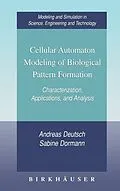This book focuses on a challenging application field of cellular automata: pattern formation in biological systems, such as the growth of microorganisms, dynamics of cellular tissue and tumors, and formation of pigment cell patterns. These phenomena, resulting from complex cellular interactions, cannot be deduced solely from experimental analysis, but can be more easily examined using mathematical models, in particular, cellular automaton models.
While there are various books treating cellular automaton modeling, this interdisciplinary work is the first one covering biological applications. The book is divided into three parts: Part I deals with general principles, theories, and models of pattern formation; Part II examines cellular automaton modeling; and Part III explains various applications. The models and analytic techniques described may be extended to other exciting applications in biology, medicine, and immunology.
Key topics and features:
* Provides an introduction and historical account of the principles of biological pattern formation (morphogenesis) * Gives an overview of mathematical modeling approaches to morphogenesis, and an introduction to cellular automata and analytic techniques * A supplementary web-based Java applet---Cellular Automaton Simulator---enables interactive simulation of various cellular automaton applications described in the book; available on the internet at www.biomodeling.info * Self-contained presentation is accessible to a broad audience; only basic calculus and linear algebra are required * Careful balance of theory, models, and applications useful to both experimentalists and theoreticians * Includes suggestions for further research topics
The book is aimed at researchers, practitioners, and students in applied mathematics, mathematical biology, computational physics, bioengineering, and computer science interested in a cellular automaton approach to biological modeling. The book's accessible presentation and interdisciplinary approach make it suitable for graduate and advanced undergraduate courses and seminars in mathematical biology, biomodeling, and biocomputing.
Zusammenfassung
The recent dramatic advances inbiotechnology have led to an explosion of data in the life sciences at the molecular level as well as more detailed observation and ch- acterization at the cellular and tissue levels. Itis now absolutely clear that one needs a theoretical framework inwhich to place this data to gain from it as much information as possible. Mathematical and computational modelling approaches are the obvious waytodothis. Heeding lessons from the physical sciences, one might expect that all areas in the life sciences would be actively pursuing quantitative methods to c- solidate the vast bodies of data that exist and to integrate rapidly accumulating new information. Remarkably, with a few notable exceptions, quite the contrary situation exists. However, things are now beginning to change and there is the sense that we are at the beginning of an exciting new era of research inwhich the novel problems posed by biologists will challenge the mathematicians and computer scientists, who, in turn, will use their tools to inform the experimentalists, who will verify model predictions. Only through such a tight interaction among disciplines will we have the opportunity to solve many of the major problems in the life sciences. One such problem, central to developmental biology, is the understanding of how various processes interact to produce spatio-temporal patterns in the embryo.
Inhalt
General Principles, Theories, and Models of Pattern Formation.- and Outline.- On the Origin of Patterns.- Mathematical Modeling of Biological Pattern Formation.- Cellular Automaton Modeling.- Cellular Automata.- Applications.- Random Movement.- Growth Processes.- Adhesive Cell Interaction.- Alignment and Cellular Swarming.- Pigment Cell Pattern Formation.- Tissue and Tumor Development.- Turing Patterns and Excitable Media.- Discussion and Outlook.
